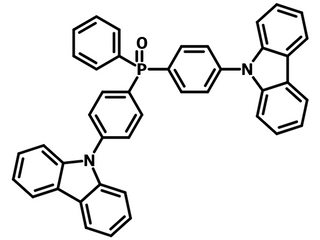BCPO
CAS Number 1233407-28-7
Fluorescent Host Materials, High Purity Sublimed Materials, Host Materials, Materials, OLED Materials, Phosphorescent Host Materials,BCPO, bipolar host material
Universal host to blue, green and red fluorescent and phosphorescent devices, Sublimed, ≥99%, Bis-4-(N-carbazolyl)phenyl)phenylphosphine oxide, CAS No. 1233407-28-7
BCPO is a bipolar host material containing phenylphosphine oxide as an electron withdrawing moiety and two carbazolyl groups as electron donating moieties. BCPO possesses a high triplet energy (ET ) of 3.01 eV and a high glass transition temperature (Tg) of 137 °C. The phosphine oxide moiety in the middle of the structure can effectively cut off the electron communication between the two N-phenyl carbazole groups, leading to a much higher triplet energy of BCPO than CBP.
Like CBP and mCBP, BCPO can be used as a universal host to blue, green and red fluorescent and phosphorescent devices using simple device architectures.
General Information
| CAS number | 1233407-28-7 |
|---|---|
| Full name | Bis-4-(N-carbazolyl)phenyl)phenylphosphine oxide |
| Chemical formula | C42H29N2OP |
| Molecular weight | 608.67 g/mol |
| Absorption | λmax 292 nm in DCM |
| Fluorescence | λmax 388 nm in DCM |
| HOMO/LUMO | HOMO = 5.76 eV, LUMO = 2.19 eV; ET = 3.01 eV [1] |
| Synonyms | 9,9′-(4,4′-(Phenylphosphoryl)bis-(4,1-phenylene))bis(9H-carbazole) |
| Classification / Family | Carbazole derivatives, Bipolar host materials, Fluorescent host materials, Phosphorescent host materials, TADF materials, Organic printed electronics. |
Product Details
| Purity | Sublimed > 99% (HPLC) |
|---|---|
| Melting point | Tg = 137 °C |
| Appearance | White crystals/powder |
Chemical Structure

Device Structure(s)
| Device structure | ITO/NPB (10 nm)/TCTA (20 nm)/BCPO:FIr6 (7–8%, 30 nm)/BCP (10nm)/Alq (50 nm)/LiF (1 nm)/Al (100 nm) [1] |
|---|---|
| Color | Blue |
| Max. Luminance | 28,718 cd/m2 |
| Max. Current Efficiency | 36.8 cd/A |
| Max. EQE | 19.8% |
| Max. Power Efficiency | 33.1 lm W-1 |
| Device structure | ITO/HATCN (4.2 nm)/TAPC (34 nm)/BCPO: 5 wt% p-AC-DBNA* (23 nm)/TmPyPB (21 nm)/LiF (1 nm)/Al (100 nm) [2] |
|---|---|
| Color | Sky-blue |
| Max. Luminance | 28,600 cd/m2 |
| Max. Current Efficiency | 43.0 cd/A |
| Max. EQE | 19.3% |
| Max. Power Efficiency | 42.3 lm W-1 |
| Device structure | ITO/HATCN (4.2 nm)/TAPC (34 nm)/BCPO: 5 wt% p-AC-DBNA* (23 nm)/TmPyPB (21 nm)/LiF (1 nm)/Al (100 nm) [2] |
|---|---|
| Color | Green |
| Max. Luminance | 69,160 cd/m2 |
| Max. Current Efficiency | 54.4 cd/A |
| Max. EQE | 19.2% |
| Max. Power Efficiency | 49.8 lm W-1 |
| Device structure | ITO/HATCN (4.2 nm)/TAPC (34 nm)/BCPO: 10 wt% m-AC-DBNA* (23 nm)/TmPyPB (21 nm)/LiF (1 nm)/Al (100 nm) [2] |
|---|---|
| Color | Sky-blue |
| Max. Luminance | 24,600 cd/m2 |
| Max. Current Efficiency | 42.0 cd/A |
| Max. EQE | 17.1% |
| Max. Power Efficiency | 34.1 lm W-1 |
| Device structure | ITO/NPB(40 nm)/TCTA(10 nm)/TAT-3DBTO2*:BCPO(1:9,30 nm)/TPBi(40 nm)/LiF(1 nm)/Al (100 nm) [3] |
|---|---|
| Color | Green |
| Max. Luminance | 10,420 cd/m2 |
| Max. Current Efficiency | 50.8 cd/A |
| Max. EQE | 30.9% |
| Max. Power Efficiency | 38.7 lm W-1 |
| Device structure | ITO/NPB (20 nm)/ TCTA (10 nm)/BCPO:Ir(ppy)3 (8% 30 nm)/TPOTP (40 nm)/LiF (1 nm)/Al (100 nm) [4] |
|---|---|
| Color | Green |
| Max. Luminance | 115,000 cd/m2 |
| Max. Current Efficiency | 97.6 cd/A |
| Max. EQE | 25.2% |
| Max. Power Efficiency | 101 lm W-1 |
| Device structure | ITO/NPB (30 nm)/mCP (20 nm)/BCPO Firpic (8 wt%) (30 nm)/ TPOTP (40 nm)/LiF (1 nm)/Al (100 nm); [4] |
|---|---|
| Color | Sky-blue |
| Max. Luminance | 35,600 cd/m2 |
| Max. Current Efficiency | 49.1 cd/A |
| Max. EQE | 23.1% |
| Max. Power Efficiency | 41.8 lm W-1 |
*For chemical structure information, please refer to the cited references
Pricing
| Grade | Order Code | Quantity | Price |
|---|---|---|---|
| Sublimed (>99% purity) | M2198A1 | 100 mg | £260 |
| Sublimed (>99% purity) | M2198A1 | 250 mg | £520 |
| Sublimed (>99% purity) | M2198A1 | 500 mg | £850 |
| Sublimed (>99% purity) | M2198A1 | 1 g | £1450 |
MSDS Documentation
Literature and Reviews
- A Highly Efficient Universal Bipolar Host for Blue, Green, and Red Phosphorescent OLEDs, H. Chou et al., Adv. Mater., 22, 2468–2471 (2010); DOI: 10.1002/adma.201000061.
- Isomeric Bright Sky-Blue TADF Emitters Based on Bisacridine Decorated DBNA: Impact of Donor Locations on Luminescent and Electroluminescent Properties, G. Meng et al., Adv. Optical Mater., 7, 1900130 (2019); DOI: 10.1002/adom.201900130.
- Triazatruxene: A Rigid Central Donor Unit for a D–A3 Thermally Activated Delayed Fluorescence Material Exhibiting Sub-Microsecond Reverse Intersystem Crossing and Unity Quantum Yield via Multiple Singlet–Triplet State Pairs, P. L. dos Santos et al., Adv. Sci., 5, 1700989 (2018); DOI: 10.1002/advs.201700989.
